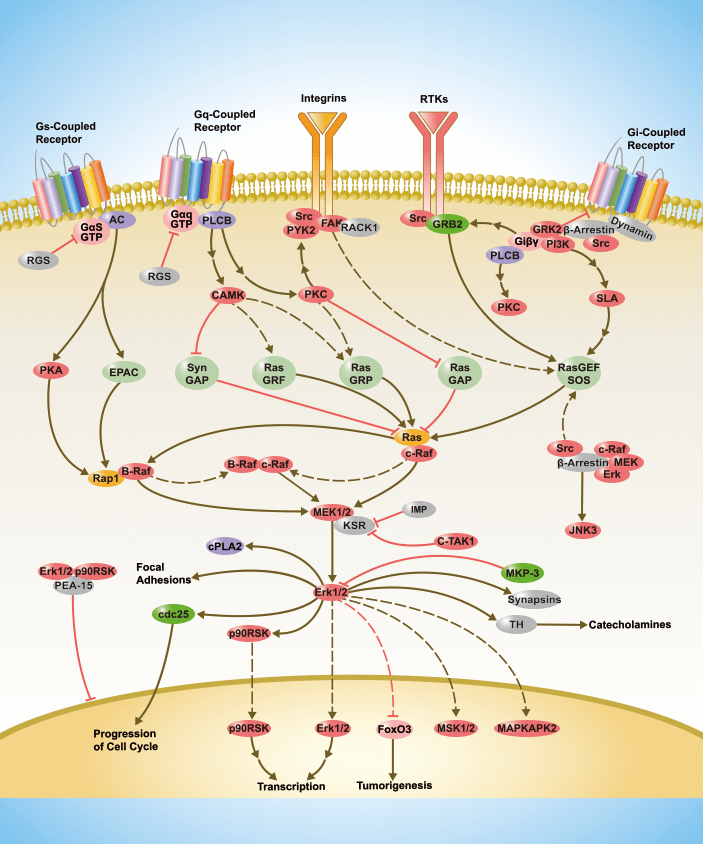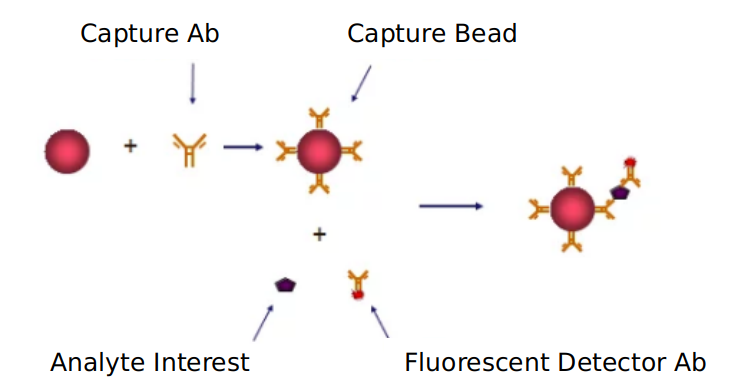Introduction to GPCR signaling pathway
Based on Luminex technology platform, Creative Proteomics provides analysis services for key targets of GPCR signaling pathway.
 G protein-coupled receptors (GPCRs) are a large family of cell surface transmembrane receptors. More than 800 members have been discovered. They are involved in a variety of life activities and various physiological processes such as endocrine and metabolism. The occurrence, development and treatment of important diseases such as, tumors and immune diseases are closely related. Based on the important biological role of GPCRs in physiological and pathological processes, this protein family has now become the most important drug target library.
G protein-coupled receptors (GPCRs) are a large family of cell surface transmembrane receptors. More than 800 members have been discovered. They are involved in a variety of life activities and various physiological processes such as endocrine and metabolism. The occurrence, development and treatment of important diseases such as, tumors and immune diseases are closely related. Based on the important biological role of GPCRs in physiological and pathological processes, this protein family has now become the most important drug target library.
G protein-coupled receptors are only found in eukaryotes and are involved in many cell signal transduction processes. In these processes, G protein-coupled receptors can bind to chemicals in the surrounding environment of the cell and activate a series of signaling pathways in the cell, ultimately causing changes in the cell state. Known ligands that bind to G protein-coupled receptors include odors, pheromones, hormones, neurotransmitters, chemokines, and so on. These receptors can be small molecules of carbohydrates, lipids, polypeptides, or proteins and other biological macromolecules.
GPCR regulate a variety of normal biological processes, and play a role in the pathophysiology of many diseases after dysregulation of downstream signal activities. The intracellular signaling pathways activated by GPCR signals include cAMP/PKA pathway, PKC pathway, Ca2+/NFAT pathway, PLC pathway, PTK pathway, PKC/MEK pathway, MAPK pathway, p38MAP pathway, PI3K pathway, Rho pathway, NF-κB pathway and JAK/STAT pathway. GPCR regulates a variety of biological processes, such as vision, smell, autonomic nervous system, and behavior. GPCR recognizes various ligands and stimuli, including peptide and non-peptide hormones and neurotransmitters, chemokines, prostaglandins and proteases, biogenic amines, nucleosides, lipids, growth factors, odor molecules, and light. The development of drug screening assays requires investigation of the target and related GPCR expression and function in the selected cell-based model system, as well as the expression of related GPCRs, to assess direct and potential off-target side effects.
Our detectable targets:
| JNK3 | PI3K | PKC | STAT1 | STAT2 | STAT3 |
| EPAC | IRAK4 | JNK | MYD88 | RTKs | TLR4 |
| CREB | IRF3 | MAPK | NAP1 | Rel | TLR9 |
| TCR | icam1 | Mda-5 | NFκB | RIG-1 | TRAF3 |
| GAS | IRF9 | MEKK1 | p38 | RIP1 | TRAF5 |
| CD3 | IRF5 | MEK3 | p38MAPK | SH2 | TRAF6 |
| PKA | IRS1 | MEK6 | p50 | SLP76 | TRAM |
| PSGL1 | IRS2 | MSK1 | TLR3 | Tak1 | TRIF |
| TNFR | ISGF3 | MSK2 | PI3K | TBK1 | Vav |
| Fas | ISRE | mTOR | PKR |
Technology platform:
We provide Luminex technology for GPCR signaling pathway analysis.
Luminex technology is a multifunctional liquid phase analysis platform developed on the basis of colored microspheres, laser technology, applied fluidics and high-speed digital signal processing technology. The core is to encode polypropylene microspheres or magnetic microspheres with fluorescent dyes. By adjusting the different ratios of the two fluorescent dyes, up to 100 microspheres with different fluorescence spectra can be obtained. Antigen-antibody, enzyme-substrate, ligand-receptor binding reactions and nucleic acid hybridization reactions are performed on microspheres with different fluorescence encoding. Qualitative and quantitative analysis by laser detection of microsphere coding and reporter fluorescence separately.
GPCRs regulate a variety of normal biological processes and are one of the most manageable drug target categories, and play a role in the pathophysiology of many diseases after their downstream signal activities are dysregulated.
In addition to Luminex Multiplex Assay, Enzyme-linked immunosorbent assay (ELISA), Flow cytometry (FACS analysis) technology can also be provided to meet other customer needs.
Advantages of GPCR signaling pathway detection:
- High sensitivity: The surface area of the microspheres is large, and 100,000 probes can be fixed on each microsphere, which ensures the maximum binding with the target molecules in the sample and improves the detection sensitivity. The lowest detection concentration can reach 0.1pg/mL.
- Strong specificity: Can read the fluorescent signal on a single microsphere, and automatically distinguish between bound and unbound microspheres.
- High accuracy: Without washing, the fluorescence intensity of the reporter molecule on the microsphere is proportional to the bound molecule to be detected. Because the detection range of the Luminex detection platform is large, it does not need to be diluted like ELISA detection, which further reduces errors.

Application of our service:
- To study the regulation mechanism of GPCR signal pathway in disease
- To study the effect of each virus on GPCR signaling pathway
- To study the effects of drugs or therapies on GPCR signaling pathways
Creative Proteomics has developed a signal pathway target detection platform. We are not limited to providing GPCR signal path detection services, but can also provide other signal path detection services. If you want to detect other targets, please contact us and we will customize the service for you. Look forward to working with you.
References:
- J Robert Lane, Lauren T May, et al. A kinetic view of GPCR allostery and biased agonism. Nature Chemical Biology, 2017, 13: 929–937.
- Mei-Juan Cai, Du-Juan Dong, et al.G-protein-coupled receptor participates in 20-hydroxyecdysone signaling on the plasma membrane. Cell Communication and Signaling, 2019, 12(9).



